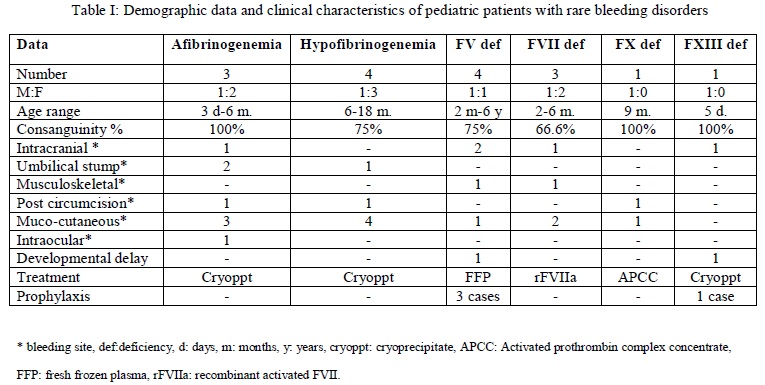
Contributions
Type: Publication Only
Background
Rare bleeding disorders (RBDs) are autosomal recessive heterogeneous group of inherited coagulation factor deficiencies, with a prevalence varying between 1:500,000 and 1:2,000,000. Remarkably, there is a paucity of data on RBDs from the Middle East. Despite education and social modernization, Oman still has a high prevalence of consanguineous marriage, reaching more than 50% of all registered marriages. Being mostly autosomal recessive, RBDs are expected to be relatively high in such community compared to western countries.
Aims
The aim of the current work is to study the demographic characteristics, clinical presentations and management of RBDs in Omani pediatric patients.
Methods
Retrospective data analysis of all children diagnosed with inherited coagulation factor deficiencies in Pediatric Hematology Unit, Sultan Qaboos Universsity Hospital, Muscat, Oman from January 2009 till December 2014.
Results
Deficiencies of fibrinogen, FV, FVII, FX and FXIII were diagnosed in 16 pediatric patients (7 males and 9 females), accounting for 9.5% (16/169) of all children with inherited coagulation factor deficiencies. The age ranged from 3 days to 6 years and consanguineous marriages were found in 13/16 cases (81.3%). The clinical spectrum varied from mild mucocutaneous bleeding to serious sight-threatening retrobulbar and intraocular hemorrhage with subsequent unilateral enucleation. As an initial presentation, intracranial hemorrhage occurred in 5/16 cases (31.3%). Two patients (12.5%) suffered from global developmental delay due to severe intracranial hemorrhage in early infancy. Four patients (3 with FV deficiency and 1 with FXIII deficiency) are on regular prophylaxis. The detailed demographic data, clinical presentations, complications and management of all patients are shown in table I.
Summary
In conclusion, children with RBDs constitute almost one tenth of cases of hereditary coagulation factor deficiencies in our center. They have some unique features in terms of severity, clinical profile and the need for prophylaxis early in life.
We recommend establishing a national/regional registry of RBDs in collaboration with other centres in Oman and the Middle East. This will serve to identify the epidemiology, clinical presentations, genotype-phenotype correlation and therapeutic options of such rare, yet significant disorders in this part of the world.
Keyword(s): Bleeding disorder

Type: Publication Only
Background
Rare bleeding disorders (RBDs) are autosomal recessive heterogeneous group of inherited coagulation factor deficiencies, with a prevalence varying between 1:500,000 and 1:2,000,000. Remarkably, there is a paucity of data on RBDs from the Middle East. Despite education and social modernization, Oman still has a high prevalence of consanguineous marriage, reaching more than 50% of all registered marriages. Being mostly autosomal recessive, RBDs are expected to be relatively high in such community compared to western countries.
Aims
The aim of the current work is to study the demographic characteristics, clinical presentations and management of RBDs in Omani pediatric patients.
Methods
Retrospective data analysis of all children diagnosed with inherited coagulation factor deficiencies in Pediatric Hematology Unit, Sultan Qaboos Universsity Hospital, Muscat, Oman from January 2009 till December 2014.
Results
Deficiencies of fibrinogen, FV, FVII, FX and FXIII were diagnosed in 16 pediatric patients (7 males and 9 females), accounting for 9.5% (16/169) of all children with inherited coagulation factor deficiencies. The age ranged from 3 days to 6 years and consanguineous marriages were found in 13/16 cases (81.3%). The clinical spectrum varied from mild mucocutaneous bleeding to serious sight-threatening retrobulbar and intraocular hemorrhage with subsequent unilateral enucleation. As an initial presentation, intracranial hemorrhage occurred in 5/16 cases (31.3%). Two patients (12.5%) suffered from global developmental delay due to severe intracranial hemorrhage in early infancy. Four patients (3 with FV deficiency and 1 with FXIII deficiency) are on regular prophylaxis. The detailed demographic data, clinical presentations, complications and management of all patients are shown in table I.
Summary
In conclusion, children with RBDs constitute almost one tenth of cases of hereditary coagulation factor deficiencies in our center. They have some unique features in terms of severity, clinical profile and the need for prophylaxis early in life.
We recommend establishing a national/regional registry of RBDs in collaboration with other centres in Oman and the Middle East. This will serve to identify the epidemiology, clinical presentations, genotype-phenotype correlation and therapeutic options of such rare, yet significant disorders in this part of the world.
Keyword(s): Bleeding disorder



